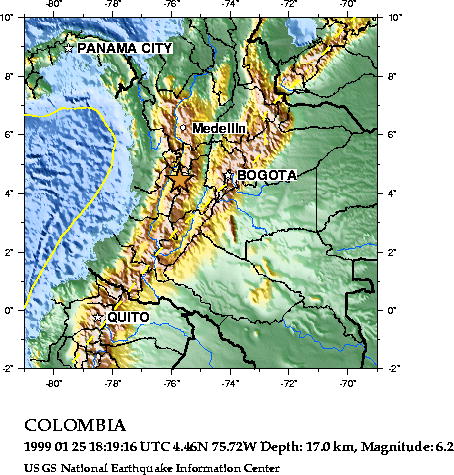- 1999 Armenia, Colombia earthquake
Earthquake
title=1999 Colombia earthquake
date=January 25 ,1999 
caption = Location of epicenter within Columbia
magnitude = 6.2 Mw [http://neic.usgs.gov/neis/eq_depot/1999/eq_990125/ Magnitude 6.2 Columbia] "United States Geological Survey "]
depth=convert|17|km|mi|0
location=coord|4.46|N|75.72|W
countries affected = COL
casualties = Approximately 2,000, with 4,000 injured. [http://news.bbc.co.uk/onthisday/hi/dates/stories/january/25/newsid_2506000/2506407.stm 1999: Colombia quake leaves hundreds dead] "BBC News "] The 1999 Armenia earthquake is anatural disaster that affected heavily the city ofArmenia, Colombia in theQuindio department, 18 towns and 28 villages in theColombian Coffee-Growers Axis region departments, and in a lesser degree, the cities ofPereira andManizales .The
earthquake occurred on Monday, 25th January, 1999 13:19 (18:19:17 GMT) with an intensity of 6.4 degrees in theRichter scale .Theepicenter was 25 miles (40 km) west south west ofIbague , Colombia. It was the strongest earthquake to strike Colombia for 16 years, and aftershocks were felt in the capital ofBogota .Causes
This area has a well known high seismic risk, due to the triple junction that occurs at the northwest corner of the
South American Plate where the Nazca, Cocos, and Pacific plates converge.About 60% of the existent structures in Armenia collapsed, due to the high amount of old structures, built without technical requirements and the lack of urban planning and land studies.Aftershock s14 earthquake aftershocks were detected, the first and strongest registered at 17:40:18 (22:40:18 GMT) with 5.4 degrees in the Richter scale. Other aftershocks that caused panicking among the inhabitants were: The 29th at 23:33 (4.2 degrees) and the 31th at 03:03 (3.5 degrees)
Death toll
The earthquake hit Colombia's coffee-growing region, and toppled tower blocks, hotels, and historic churches in Bogota. Most of these buildings that collapsed were old and poorly constructed, or were built on poor soil such as old landfill sites or steep slopes. The newer structures, for the most part, survived intact due to safety measures being established in
1984 .The worst hit part of the country were regional capitals of Armenia and
Pereira . In Armenia, about 10 miles (17km) south of the epicentre, single-storey homes were demolished by the seismological event. The initial earthquake produced a rough casualty estimate of about 1000 people. The first (17:40) earthquake replica produced a still indeterminate number of victims among the people trying to remove their goods from the semi-collapsed structures. The subsequentriots , robberies to the injured victims, attacks to the shops and homes, and fights for food, water and accommodation raised the total number of deaths to over 2000. The corpses that were retrieved were carried to the local Quindio University auditorium to be identified by their relatives. Since the forensic services were out, many of them cannot be recognized and were buried in common tombs.Injured
The structures of many hospitals were damaged, and the resources available for health care were insufficient even before the event. Furthermore, the area had limited reaction plans case of disasters and little experience with
triage . As a consequence, the attention of the victims was chaotic. About 4,000 people with various degrees of lesions were attended in the remaining health care centers of the city. An undetermined number of injured victims (many of them unidentified) were carried by airplane to different cities (mainlyBogotá ,Medellín , andCali ), and out of the country.Missing persons
The amount of missing persons as a result of the earthquake is estimated near to 3900. Some factors involved in the disappearance of this people are the security issues due to the riots, the collapse of communications and roads, the lack of coordination of the rescue forces, dispatch of the injured victims and identification of the corpses.
Economic impact
The main economic activity of the region, the
Colombian coffee industry was heavily affected. About 8.000 coffee farms were complete or partially destroyed, also 13.000 structures of several kinds of enterprises and industries were damaged and went temporarily or permanently out of service. The banks and financial entities cannot dispense money for several weeks.Aftermath
Colombian authorities imposed a dawn-till-dusk curfew after the earthquake, to allow rescue workers to work untarnished. Looting was widespread in Armenia after residents, disturbed by the slow movement of the relief effort, broke into food stores and stealing supplies. Then Colombian president
Andres Pastrana postponed a trip to Germany to attend a World Bank meeting to view the destruction himself. He later had to send soldiers to the afflicted area to restore order.In January 2002, three years after the earthquake hit, the new community of
El Cantaro was finished. [http://news.bbc.co.uk/onthisday/hi/dates/stories/january/25/newsid_2506000/2506407.stm 'From death to life': Three years after earthquake, El Cantaro celebrates new homes] "Mennonite Central Committee (MCC)" By Elizabeth Soto and Frank Albrecht] Many of the 125 families that gathered to celebrate the completion of their homes were chosen among the neediest. An ecological park was created further down the eponymous stream.References
*ARANGO, J. D. y QUINTERO, B. E. Dianóstico del Sismo del 25 de enero de 1999. In: Boletin de la Red Sismológicadel Eje Cafetero. Vol.8 Manizales: 2000 46 – 53 p.
*BAKER, V. R. Regional Landforms Analysis. NASA, Red mundial, 2001.
*CARDONA, O. D. Lessons in Seismic Engineering and Disaster Prevention. SpecialReport. The Earthquake of Armenia, Colombia, January 25, 1999. GeohazardsInternational. Red mundial, 2000. Www.geohaz.org/member/report/cardeng99.html
Wikimedia Foundation. 2010.
